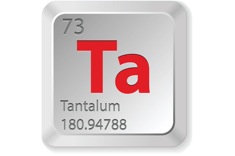Facts About Tantalum

Atomic Number: 73 Atomic Symbol: Ta Atomic Weight: 180.94788 Melting Point: 5,462.6 F (3,017 C) Boiling Point:9,856.4 F (5,458C)
Word origin: Tantalum is named after a Greek mythological character, Tantalos.
Discovery: Tantalum was discovered by Anders Ekeberg in 1802. It was thought tantalum and niobium were identical elements until Rowe in 1844, and Swiss chemist Jean Charles Galissard de Marignac, in 1866 showed they were different acids.
Properties of tantalum
Tantalum is a hard, grey, ductile metal. In its pure form, it can be drawn into a fine wire. Tantalum is nearly immune to chemical attacks at temperatures below 302 F (150 C). Tantalum oxide films are very stable and have good rectifying as well as dielectric properties. It has a melting point only exceeded by two other elements and becomes much more reactive at high temperatures. [See Periodic Table of the Elements]
Sources of tantalum
Tantalum occurs naturally in the mineral columbite-tantalite. It’s mainly found in in Australia, Brazil, Mozambique, Thailand, Portugal, Nigeria, Zaire and Canada. Separating tantalum from niobium requires either electrolysis, reduction of potassium fluorotantalate with sodium or reacting the carbide with oxide. Natural tantalum contains two isotopes while twenty-five isotopes are known to exist.
Uses of tantalum
Tantalum is used in a variety of alloys to add high strength, ductility and a high melting point. When drawn into a fine wire, it’s used as a filament for evaporating metals such as aluminum. More than half of tantalum’s use is for electrolytic capacitors and vacuum furnace parts. The element is also used to make chemical process equipment, nuclear reactors, aircraft and missile parts. Tantalum has found use in making surgical appliances because it’s completely immune to body liquids. Tantalum oxide is used to make special glass with high index of refraction for items such as camera lenses.
(Source: Los Alamos National Laboratory)
Sign up for the Live Science daily newsletter now
Get the world’s most fascinating discoveries delivered straight to your inbox.











